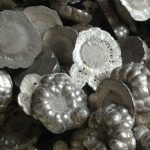Notice: Undefined index: sith_hide_share in /www/sites/alloy.wiki/index/wp-content/themes/likegoogle/single.php on line 32
Deprecated: get_settings is deprecated since version 2.1.0! Use get_option() instead. in /www/sites/alloy.wiki/index/wp-includes/functions.php on line 4862
Titanium alloys are active metals and are widely used in aerospace, petrochemical and atomic energy industries. The main problems in titanium and titanium alloy brazing are as follows:
(1)The oxide film on the surface is stable, titanium and its alloys have a large affinity with oxygen, and the surface is easy to produce a very stable oxide film, thus wetting and spreading the solder, so it must be removed during brazing.
(2)Titanium and its alloys tend to absorb hydrogen, oxygen and nitrogen in the heating process, and the higher the temperature, the more serious the absorption, resulting in a sharp reduction in the plasticity and toughness of titanium metal, so brazing should be carried out in a vacuum or inert atmosphere.
(3)It is easy to form intermetallic compound, titanium and its alloy can react with most needle materials to produce brittle compound, resulting in brittle joint. Therefore, the solder used for brazing other materials is generally not suitable for brazing active metals.
(4)Organization and performance are subject to change. Titanium and its alloys undergo phase transition and grain coarsening when heated. The higher the temperature, the more severe the coarsening. Therefore, the temperature of high-temperature brazing should not be too high.
In conclusion, the brazing heating temperature must be paid attention to when brazing titanium and its alloys. Generally speaking, the brazing temperature should not exceed 950 ~ 1000℃, the lower the brazing temperature, the less influence on the base material properties. For quenching aging alloys, brazing can also be done under the condition of aging temperature.
In order to prevent oxidation, oxygen absorption and hydrogen absorption reaction of brazing joint, titanium and titanium alloy brazing is carried out in vacuum and emotional atmosphere, generally do not use flame brazing. When brazing in vacuum or chlorine gas, high frequency heating and furnace heating can be used. The heating speed is fast and the holding time is short. Therefore, it is necessary to control the temperature and holding time of needle welding so that the filler can flow to the full gap.
The reason why titanium and titanium alloys are best brazed in vacuum and argon is that during vacuum brazing, although titanium has a great affinity for oxygen, titanium can obtain a smooth surface at 13.3Pa vacuum, which is caused by the oxide film on the surface that can dissolve into titanium.
When brazing under the protection of argon, the brazing temperature range is 760 ~ 927℃. In order to prevent the discoloration of titanium, high-purity argon is required. Liquid argon in refrigerated storage containers is generally used because of its high purity.
When brazing titanium and titanium alloys, brittle compounds are often formed on the interface or in the brazing joint, reducing the performance of brazing joint. The diffusion welding method can be used to improve the performance of brazed joint. During brazing, copper foil, nickel foil or silver foil of 50 m thick were placed between the titanium alloys, and cu-ti, ni-ti and ag-ti eutectic were formed by the contact reaction between titanium and these metals. Then these brittle intermetallic compounds are diffused, and the joints with diffused brazing at a certain temperature and time have good performance.
In addition, a+B phase titanium alloy can be used in annealing, solution treatment or aging state. If annealing is required after brazing, three options are available: annealing at or below annealing temperature after annealing; The temperature above the annealing temperature is brazed, and the segmental cooling process is adopted in the brazing cycle to obtain the annealing structure. The temperature above the annealing temperature is brazed and then annealed.
Guest contributors are welcome at the Alloy Wiki.It is a weekly wiki and guide on alloy information and processing technology, while also about the vast array of opportunities that are present in manufacturing. Our team of writers consists of a Machining Material Supplier / Machinist / Tool and Die Maker, a Biomedical Engineer / Product Development Engineer, a Job Development Coordinator / Adjunct Professor, and a President and CEO of a manufacturing facility.
Link to this article:Best brazing method for titanium and its alloys
Reprint Statement: If there are no special instructions, all articles on this site are original. Please indicate the source for reprinting:Alloy Wiki,thanks!^^


